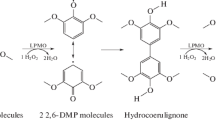Abstract
The esterase isozymes of Paramecium aurelia grown in the presence and absence of bacteria were examined by starch gel electrophoresis. Where present, bacteria make a positive contribution to the esterase zymograms. Different bacteria contribute different esterases. Paramecia growing in axenic medium possess a different esterase which is not produced by the same parmecia growing in the presence of bacteria. This axenic esterase disappears when bacteria are added back to the medium.
Similar content being viewed by others
References
Allen, S. L., and Gibson, I. (1971). Intersyngenic variations in the esterases of axenic stocks of Paramecium aurelia. Biochem. Genet. 5 161.
Allen, S. L., and Weremiuk, S. L. (1971). Intersyngenic variations in the esterases and acid phosphatases of Tetrahymena pyriformis. Biochem. Genet. 5 119.
Allen, S. L., Byrne, B. C., and Cronkite, D. L. (1971). Intersyngenic variations in the esterases of bacterized Paramecium aurelia. Biochem. Genet. 5 135.
Soldo, A. T., Godoy, G. A., and van Wagtendonk, W. J. (1966). Growth of particle-bearing and particle-free Paramecium aurelia in axenic culture. J. Protozool. 13 492.
Author information
Authors and Affiliations
Additional information
Supported by a research grant from the Science Research Council.
Rights and permissions
About this article
Cite this article
Rowe, E., Gibson, I. & Cavill, A. The effects of growth conditions on the esterases of Paramecium aurelia . Biochem Genet 5, 151–159 (1971). https://doi.org/10.1007/BF00485642
Received:
Revised:
Issue Date:
DOI: https://doi.org/10.1007/BF00485642




